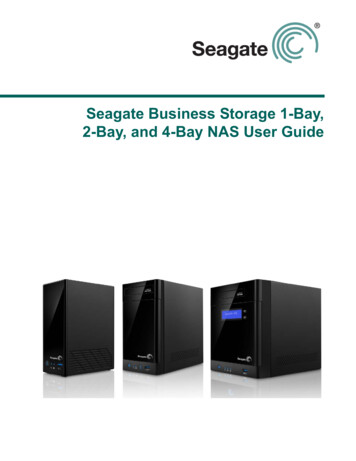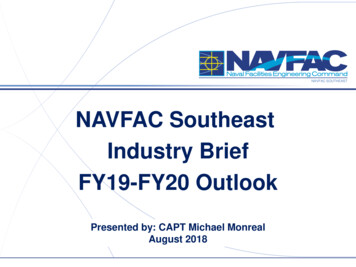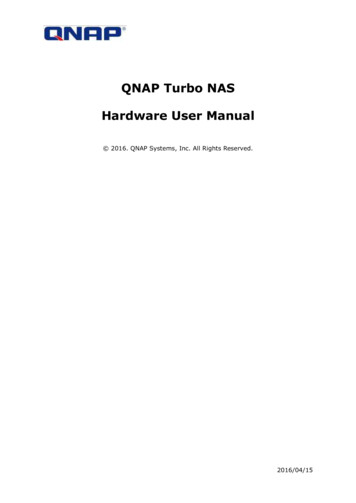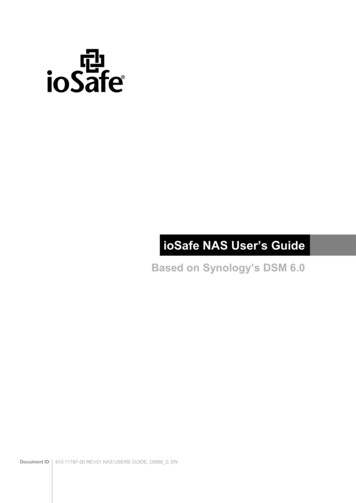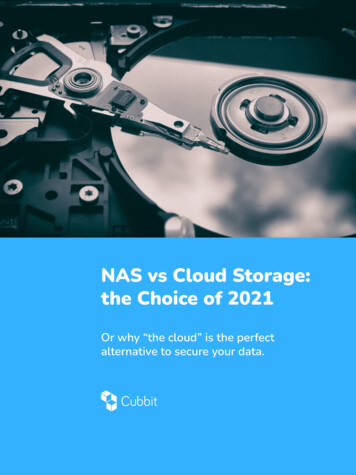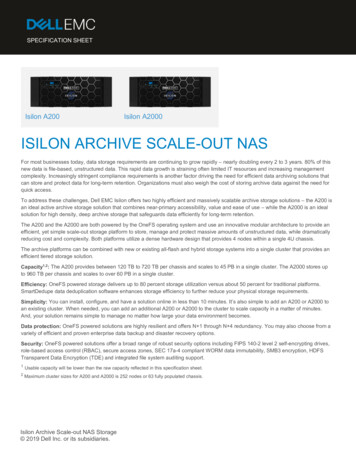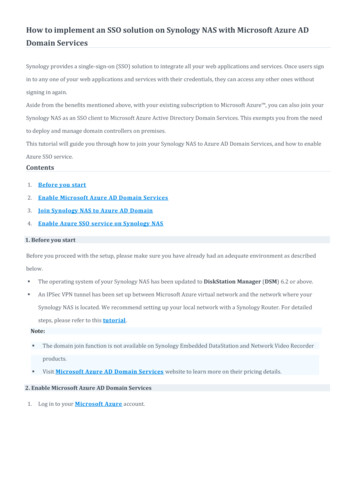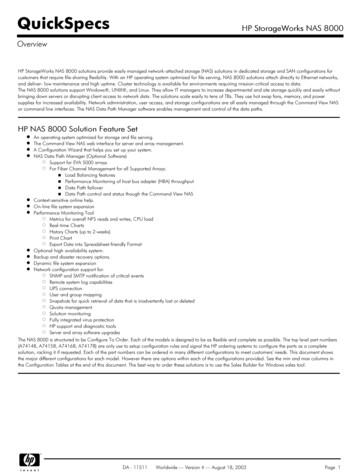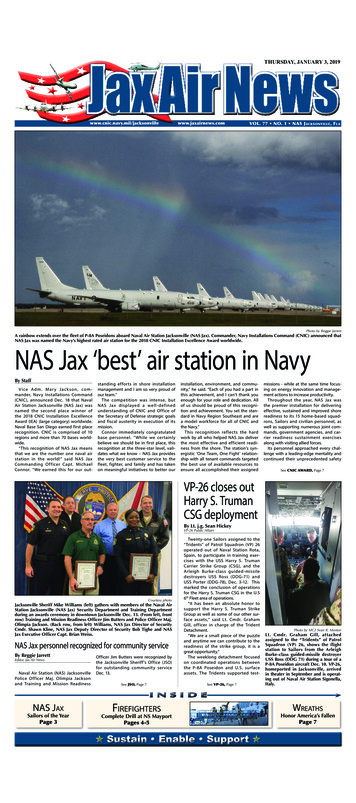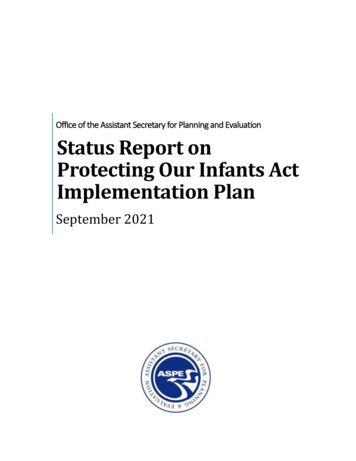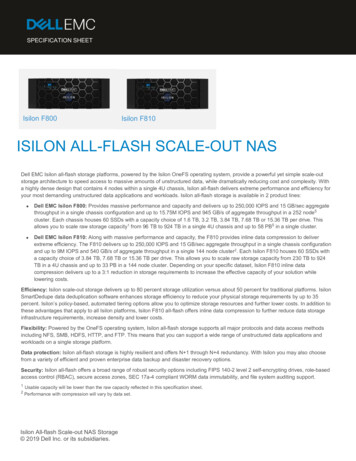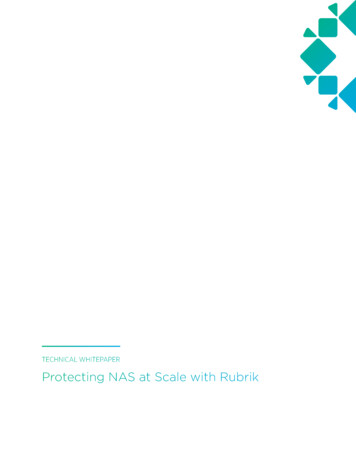
Transcription
TECHNICAL WHITEPAPERProtecting NAS at Scale with Rubrik
TABLE OF CONTENTSAUDIENCE. 3EXECUTIVE SUMMARY. 3NDMP IS NOT THE ANSWER. 3A Short History of NDMP. 3NDMP Limitations.4PROTECTING NAS WITH RUBRIK. 5Three-Phase Approach. 5Scan. 5Scan with No API Integration. 6Scan with Snapshot API Integration. 8Scan with Snapshot and File Change APIs Integration. 9Fetch. 10Copy. 10Rubrik Direct Archive.11Global Search and Rapid Recovery.12BENEFITS OF USING RUBRIK.13CONCLUSION.13ABOUT THE AUTHORS.13TECHNICAL WHITEPAPER PROTECTING NAS AT SCALE WITH RUBRIK
AUDIENCEThis white paper is intended for Data Center Architects, Systems Administrators, Storage Administrators, andBackup Administrators who have responsibility for protecting and recovering Network Attached Storage (NAS)data. To meet the demands of today’s enterprise data growth, Rubrik provides an alternative approach tolegacy NAS protection solutions. This paper will help users make an informed decision about what approach totake in managing their NAS environments by walking through the innovations that Rubrik has invested in ourdata management solution.EXECUTIVE SUMMARYData has been growing exponentially and will continue to do so for the foreseeable future. Today, much of thatdata lives in enterprise NAS environments that are growing at a rapid rate and protecting this data requiresa next-generation data management solution that is designed and built to protect terabytes to petabytes ofunstructured data.Rubrik offers a next-generation solution that meets the requirements of today’s growing enterprise dataprotection needs. Customers using Rubrik can realize the benefits of reliable backups, rapid recovery of data,and the flexibility of a heterogeneous NAS data management solution.NDMP IS NOT THE ANSWERThe Network Data Management Protocol (NDMP) is currently the de facto approach for protecting NAS data.However, an increasing number of enterprises are exploring new approaches to protecting their data as theirenvironments grow and they are experiencing the challenges and limitations associated with NDMP.A SHORT HISTORY OF NDMPMore than two decades ago, NAS pioneer NetApp and backup vendor Intelliguard collaborated together to tryand solve an issue that was becoming increasingly vexing for NAS users - the inability to reliably protect theirdata. Up to that point, NAS platforms such as NetApp Filers were being backed up by having backup serversmount NAS shares and then moving the backup data to locally attached tape devices or to a networked tapelibrary. This solution was fraught with problems ranging from low performance due to the need to read everyfile over a POSIX interface, performance bottlenecks created by having to send data over a single mount point,and the complexity of having to manage multiple devices.NDMP was first proposed by NetApp and Intelliguard in 1995 to address these challenges in protecting NASplatforms. NDMP is officially defined as an “open standard protocol for network-based backup for networkattached storage.” The protocol specifies a separation of the control path from the data path. Control trafficpasses from the backup application to the NAS platform over an IP network while data traffic flows from theNAS platform to a storage medium over SCSI or over a Storage Area Network (SAN). NDMP also defines amechanism for allowing a backup application to initiate and manage backup jobs running across multiple NASdevices. Each NAS device would then be responsible for preparing its files to be protected and for copying filesdirectly to a locally attached or network attached storage device.TECHNICAL WHITEPAPER PROTECTING NAS AT SCALE WITH RUBRIK3
IP NetworkSCSIBackup ServerSCSIFC/IP SANNAS DeviceDisksTape DeviceTape LIbraryThe advantages of NDMP included the following: Backup traffic could be offloaded to locally attached or fibre channel attached devices, avoiding thebottlenecks created when trying to stream data across what was then typically 100 mb networks. Eliminated the need for data management vendors to write special agents or unique device drivers tobe installed for each NAS vendor’s solution. Each NAS vendor would build interfaces that adhered tothe NDMP standard. Centralized data management so that a single instance of a backup application could initiate andmanage data protection for multiple NAS devices.NDMP LIMITATIONSTwo decades later, NDMP is still the primary solution offered by most data management vendors. While it hasbeen the standard approach for NAS protection for over two decades, NDMP has limitations that has onlybecome more pronounced as the amount of data to be protected has increased over time. NDMP is designed to support single stream backups for each NAS device which has createdperformance bottlenecks during the data transfer process, particularly as file systems has grown largeralong with the number of unstructured files stored. To mitigate against performance bottleneck issue, resulting from single stream backups and metadatascanning of large file systems, many backup vendors using NDMP offer image-level backups. However,recovery of the entire file system is then required even when only a single file needs to be recovered. Designed primarily to use tape as the backup target, backups using NDMP typically require periodic fullbackups to limit issues with slow restore times which can occur with long chains of incremental backups. NDMP does not specify a data format for NAS backups, leaving that to the discretion of individual NASvendors. This has created platform incompatibilities that prevent data protected from one NAS platformto be recovered to a different NAS platform. Customers are effectively locked in to a specific NASplatform and even if they choose to move to another platform, customers will likely need to maintainTECHNICAL WHITEPAPER PROTECTING NAS AT SCALE WITH RUBRIK4
some instances of the previous platform in case older files have to be recovered. Even if a customercommits to a single vendor, any changes in the data format from one version to another may necessitatemaintaining multiple versions of the same vendor’s solution.PROTECTING NAS WITH RUBRIKTo ensure that customers are able to reliably protect their data and recover quickly from data corruption anddata loss, Rubrk takes an approach that obviates the need for complex NDMP implementations.THREE-PHASE APPROACHScan - Rubrik identifies which files need to be protectedfor full or incremental backups.2.Fetch - Rubrik takes the list of files from the Scan phaseand reads them over the NAS protocol.3.Copy - Rubrik compresses, encrypts, and writesthe data to the Rubrik cluster or to an archive locationon-premises or in the cloud.NCA3.CHFET2.1.1. SNAS protection with Rubrik utilizes a three-phase approach. Each phase is optimized using modern techniquessuch as snapshot API integration, data partitioning, and parallel file streaming.The Rubrik three-phase approach for NAS protection includes:CO PYScanAt a high-level, all NAS backups begin with a scan of one or more Rubrik filesets which enables Rubrik to create alist of files that it should protect during a given backup run. A fileset is a user-specified grouping of files and cancomprise of an entire NAS share or a subset of a share. Customers can use simple “include/exclude” expressionsto create filesets that include only files that meet a specific NICAL WHITEPAPER PROTECTING NAS AT SCALE WITH RUBRIKFormatToolsStatsOld5
In the above example, a user can create a fileset for the entire “Tom” NAS share, a fileset for only the “Tools”folder, or a fileset that includes or excludes files with a “txt” extension.Rubrik offers multiple options for scanning a NAS fileset. Each option offers different feature sets which aremade available to data management vendors, like Rubrik, via API integration. Which option is used by Rubrikwith a particular NAS vendor depends on the integration that is in place. Vendors, such as NetApp and Isilon,have made their snapshot (S) API and file change (FC) API available, enabling faster and more efficientfile scanning. Other vendors, such as Pure Storage, have made their snapshot (S) API available to enableapplication consistent snapshots. For vendors where these APIs are not available, Rubrik has implemented anoptimized approach to file scanning without leveraging API integration.Isilon, NetAppScan: S and FCSnapshotPure StorageScan: S but no FCEverything ElseScan: Neither S nor FCFetchCopyScan with No API IntegrationFile scanning has historically been the biggest bottleneck to NAS backup performance. This challenge has onlygrown as the amount of data has grown. Previous approaches, such as image-level backups, has increasedbackup performance by avoiding file scanning altogether. But that approach has made file-level recoverycomplex and slow while often locking customers into proprietary backup formats. Modern approaches such assnapshot and file change API integration has provided much needed improvement for those NAS platforms withAPI integration in place with data management platforms.When snapshot API integration is not available, Rubrik will mount the NAS share to be protected vis NFS orSMB and read the metadata of each file enumerated in a fileset. The first backup of a file system will always bea full backup which means Rubrik will scan and index every file in the fileset. For an incremental backup, Rubrikperform the following operations:1.Scan the metadata of each file to determine its mtime (the last modified time) as well as other relevantfile attributes.2.Compare the mtime of a file against the last backup time.3.1Mark a file to be protected if 2the Rubrikfile hasbeen“Lastmodifiedsince the last3 backup.comparesModified”Rubrik flags files that have beenRubrik scans the tree of thefile share to access the filesmetadata against “Last Backup” datemodifed since their last backup/Projects/File MetadataRubrik File SystemLast ModifiedLast 7/147/19/Year/libNFS and libSMBScanning LibrariesTECHNICAL WHITEPAPER PROTECTING NAS AT SCALE WITH RUBRIKFile ChangeDetected6
The operation Rubrik uses to check the mtime of a file is the stat() system call, which is used in Unix todetermine information about a file. In a Unix operating system, stat() is implemented via the “ls” commandand returns file information such as last modified time and last accessed time. Traditionally, stat() has beenimplemented in NAS using POSIX libraries. This has contributed to previous performance bottlenecks whenprotecting a NAS file system, due to inefficiencies in how file scanning is performed.Using a POSIX library, scanning a NAS share traditionally meant that a stat() call has to be made at each level ofthe NAS directory tree down to the endpoint of each file. In the example below, scanning the file system requires12 stat() calls, 4 per file.NAS To gain greater efficiencies in the scanning operation, Rubrik implemented stat() using the LIBNFS andLIBSMB libraries. Both are part of the LIBNFS open source project and offers libraries that provides POSIX-likefunctions, such as stat(), that are more efficient than POSIX. Instead of stat() calls at every level of the directorytree, Rubrik only needs to that once while scanning all the files in that same tree. In the example below,scanning the file system requires only 6 stat() calls to scan all 3 files.NAS For very large NAS file shares, the performance gains can be significant given the lowered scan time andreduced overhead of the scanning operation.Since Rubrik may have to scan an active file system when NAS snapshot API integration is not available, thereis a strong possibility that open files may be encountered. Rubrik addresses protecting open files differentlydepending on the file protocol used to access the share. Currently NFSv3, NFSv4, and SMB are supported.For filesystem running NFSv3, open files are unlocked and Rubrik will protect the file in one of two ways:1.If the application support the operation, Rubrik request any file changes stored in memory be flushed todisk before backup.2.If the application does not support request for changes to be flushed to disk, Rubrik will ignore any filechanges stored in memory and backup the version currently saved to disk.TECHNICAL WHITEPAPER PROTECTING NAS AT SCALE WITH RUBRIK7
Open FilesUnlockedNFSv3E.g.NASRubrik FlushesChanges to NAS DiskOpen File HasUnsaved ChangesIf supported by the user application, a NAS file system running NFSv4 or SMB can lock open files. When Rubrikencounters a locked file, it will bypass the file and attempt to protect it on its next backup run. If not supportedby the application, an open file will remain unlocked and Rubrik will protect it in the same way as file storedusing NFSv3.Open FilesLockedSMB, NFSv4/Projects//Year/Repeat at Next ockedScan with Snapshot API IntegrationSome NAS vendors provide a snapshot API that Rubrik has integrated with to provide additional benefitsduring the scan process. Prior to Rubrik performing a scan, an API call is made to the NAS platform to take asnapshot of the file system to be protected. Rubrik then mounts the snapshot, instead of the active file system,for file scanning.By leveraging a snapshot, Rubrik is able to protect a consistent point-in-time copy of a file system without theneed to use file locking. Changes stored in memory will be flushed to disk prior to the snapshot being taken.If files are deleted from or modified in the file system during a backup operation, they will be retained in thesnapshot and protected by Rubrik.TECHNICAL WHITEPAPER PROTECTING NAS AT SCALE WITH RUBRIK8
1Rubrik initiates backups withvendor-native snapshot API callsFiles may be added, modified ordeleted during the backup window23Rubrik retains data from 12:00pm aftercompleting scan, fetch, and copy phasesXNASAPI CallFile3.cad deletedFile3.cad in 12:00pm Snapshot12312:00pm12:02pm12:05pmAs is the case when there is no API integration with the NAS platform, Rubrik will scan a snapshot using optimizedstat() calls.Scan with Snapshot and File Change APIs IntegrationIn addition to snapshot API integration, some NAS vendors also provide file change API integrations. Using a filechange API eliminates the need to do a traditional scan for changed files. Instead, the file change API will returnto Rubrik a list of files that have been added, modified, or deleted since the last backup on their respectiveNAS platforms.Rubrik has integrated with Isilon’s ChangeList API and NetApp’s SnapDiff API to provide faster and more efficientscanning with additional vendor API integration planned. Note that snapshot API integration is required with filechange API integration.1Rubrik stores the current andprevious snapshots on the NAS Host2The File Change API identifieschanges between the two snapshots3The API returns file paths andmetadata for each changed fileChangeFile t/File2.pptDeletedProject3/Dec/File3.cadAPI (Current, Previous)NASCurrent SnapshotPrevious SnapshotThe backup workflow with the snapshot API and the file change API is as follows:1.Rubrik invokes the NAS vendor’s snapshot API to create the first backup.The snapshot will be a full copy of the active file system.2.Rubrik mounts and protects the full snapshot using our optimized scan method3.On the next run, Rubrik invokes the snapshot API again to create a new snapshot.TECHNICAL WHITEPAPER PROTECTING NAS AT SCALE WITH RUBRIK9
4.Rubrik invokes the NAS vendor’s file change API (ChangeList for Isilon or SnapDiff for NetApp) to comparethe current snapshot against the previous snapshot.5.Rubrik receives, via the file change API, a list of changes since the previous snapshot was taken. This stepobviates the need for Rubrik to conduct a scan of the file system.6.Rubrik performs an incremental backup that only include the changed files.7.Rubrik invokes the snapshot API to delete the older of the 2 remaining snapshots.FetchOnce the final list of files to be protected has been determined during the scan phase, Rubrik reads the files overeither the NFS or SMB protocol. Fetching of files is done using a number of optimization techniques.After the initial full backup, Rubrik takes an incremental forever approach to protecting NAS file systems. Only filesthat have not been modified or added since the previous backup will be fetched, significantly reducing the requiredbackup window.To take advantage of Rubrik’s parallel architecture, backups are divided into 100 to 200 GB partitions which thencan be ingested over parallel streams to different Rubrik cluster nodes. In the example below, three filesets withvarying sizes are fetched by Rubrik and divided into five 200 GB partitions. Each partition is then streamed inparallel to one or more Rubrik nodes.1Rubrik sizes the backup job usingthe file size metadata2Backups are partitioned into 200GBchunks to prepare for parallel ingest3Partitions are transferred in parallelbased on the number of nodesPartition 1500GB300GB1.0TB200GBPartition 5200GBParallelIngest200GBDuring fetching, all files are indexed by Rubrik to enable global search and rapid recovery. Files are also broken intoblocks and fingerprinted before being copied to Rubrik to enable more efficient storage of data.CopyThe last phase in the backup process is the copy phase where files from the NAS platform are streamed to theRubrik cluster or directly to an archive location.TECHNICAL WHITEPAPER PROTECTING NAS AT SCALE WITH RUBRIK10
Rubrik encrypts the data in-transit and at-restwith software and/or hardware-based encryption12The data is either written to the Direct Archivelocation to the local cluster with 4:2 erasure codingPartition nKeep on RubrikEncryptionIn-Flight(TLS 1.2)EncryptionAt-RestDirect ArchiveSW: FIPS 140-2 Compliant AES-256HW: FIPS 140-2 Level 2 HDD / SSDDuring the Copy phase, all data are encrypted using AES-256 Asymmetric Encryption and streamed in parallelto the Rubrik cluster. All data streams are encrypted, providing encryption in transit as well, and all backups arewritten to disk on the Rubrik nodes in their encrypted-at-rest state.Unlike NDMP, files are not saved in a proprietary format but retains its source formatting and can be easilyrestored to any vendor’s NAS platform.RUBRIK DIRECT ARCHIVENAS backups can be stored locally on the Rubrik cluster or sent directly to an archive location during the copyphase. Many enterprise customers with large scale NAS environments prefer the latter approach to save oncapital expenditure.Rubrik Direct Archive provides the option for customers to save NAS backup data directly to an archivelocation without having to first store it in Rubrik but still retain the benefits of global search and rapidrecovery. The archive location can be any of the following: A public cloud object storage service such as Amazon Simple Storage Service (S3), Microsoft Azure BlobStorage, or Google Cloud Storage A private cloud object storage solution such as NetApp StorageGRID An on-premises NFS storeBEFORESample NASEnvironmentAFTERRubrikFootprintSample NASEnvironmentNASNAS1.2 PBbillions of files1.2 PBbillions of filesNAS EndTarget1 Public Cloud2 NFS StoreNASApplianceISILONorTECHNICAL WHITEPAPER PROTECTING NAS AT SCALE WITH RUBRIKRubrikFootprint3 Object Store11
During fetching, Rubrik will index and store metadata about the files being protected as it would with backupsthat are being copied and stored locally on Rubrik clusters. The metadata is stored locally on Rubrik and istypically 10% of the capacity of the entire fileset. The data itself is encrypted and streamed to a designatedarchive location. Since the metadata is retained on the Rubrik cluster, customers can leverage global search andrapid recovery wherever the backup data resides.1Rubrik only retains metadata toreduce storage consumption by 90%2Rubrik uploads the data in parallelbased on network configurations3The data is encrypted and storedimmutably at the Direct Archive locationPartition 1NameTypeACLFile1.docUID 1File2.pptUID 2File3.cadUID 3Network Pipeline 1PublicCloudPartition 2Network Pipeline 2 10% Storage ConsumptionObj StorageNFSTapePrivateCloudGLOBAL SEARCH AND RAPID RECOVERYUltimately, a NAS protection solution is only as good as the ability it provides user for finding and recovering theirdata. By optimizing the use of file metadata, Rubrik simplifies and accelerates file recovery by NAS.1Rubrik indexes metadata for allfiles that enter the system2Users can access the index to search forfiles stored in Rubrik or archive locations3Files can be restored across platformsto avoid vendor lock-inRubrikfile2Archive LocationsNASNameTypeACLFile1.docUID 1File2.pptUID 2File3.cadUID 3file2.pptServerPCAll files being protected are indexed during fetching and the metadata is stored locally on the Rubrik cluster,regardless of where the data itself is stored. Users are able to use the Rubrik console or CLI to search the index forany files using the filename, type, and other attributes. There is no need to rescan the entire file system to locatethe files to be recovered. The location of a file can be on the local Rubrik cluster or in an archive location.Once the files to be recovered has been located, they can be restored to the original NAS platform, to anotherNAS platform, or a server using the same file protocol as the original NAS platform. The file location is abstractedfrom the user and the file itself can be located on any node in a Customer’s Rubrik clusters on in any archivelocation on or off premises.TECHNICAL WHITEPAPER PROTECTING NAS AT SCALE WITH RUBRIK12
BENEFITS OF USING RUBRIKThe Rubrik approach to NAS protection benefits users in a number of areas: Reliability - Rubrik ensures that customer NAS data is consistently protected by optimizing the dataprotection process and leveraging Rubrik’s scale-out architecture for parallel streaming of backup data.At a time when the risk to data is higher than ever, due to exponential data growth and new forms ofmalware, Rubrik customers know they can rely on their backups to recover from incidents and disasters. Rapid Recovery - “Time is Money” is a truism that is as valid today as it was decades ago. Every momentthat a business is down or unable to access critical data equates to lost revenue and lost opportunities.The issue is particularly acute in a large NAS environment with millions of files where all files may haveto be recovered or a single file has to be located and recovered. Rubrik customers can take advantageof Rubrik’s scale-out architecture for rapid recovery of data when recovering an entire file system. UsingRubrik’s global search capability, customers can recover a subset of files rapidly, without having tomanually search through a file system. Flexibility - By foregoing NDMP and storing NAS backup data in a standard format, Rubrik customershave the flexibility of being to protect any NAS platform and restoring the data to any other NASplatform. Customers are not locked in to a specific NAS vendor and their implementation of NDMP. Thisopens up the possibility of migrating between NAS platforms or leveraging a lower-cost NAS platformfor secondary NAS storage. Built for Growth and Scale - Rubrik’s scale-out architecture enables customers to protect their data intimes of rapid growth. Every node added to a Rubrik cluster provides not only additional capacity, butadditional performance. As new nodes are introduced, more data streams become available that canbe used to partition NAS backup data for parallel ingestion of data. Customers can also leverage theunlimited capacity of the public cloud by using NAS Direct Archive to send data directly to publiccloud storage.CONCLUSIONRubrik is the leading next-generation data management platform and is providing an increasing number ofenterprises with solutions for protecting data in their data centers and in the public cloud. Customers canleverage the ongoing innovations of the Rubrik platform to ensure their data is protected as they enter newmarkets and expand their businesses.ABOUT THE AUTHORKenneth Hui is a Senior Solutions Architect in Technical Marketing at Rubrik. He has 20 years of experiencein IT, designing and administering technical solutions for commercial and enterprise customers. Ken hasexperience working in data centers and with cloud providers. His role at Rubrik is to create content to educatefellow technologists on these technologies and how to leverage them to solve customer challenges.TECHNICAL WHITEPAPER PROTECTING NAS AT SCALE WITH RUBRIK13
passes from the backup application to the NAS platform over an IP network while data traffic flows from the NAS platform to a storage medium over SCSI or over a Storage Area Network (SAN). NDMP also defines a mechanism for allowing a backup application to initiate and manage backup jobs running across multiple NAS devices.
